VILMAR NUMISMATICSllc SHOWCASE V


Vilmar Numismatics LLC PO Box 60 Big Indian, NY 12410 vilmar@aol.com www.vilmarnumismatics.com SHOWCASE V MAY 2024
ORDERING INFORMATION AND TERMS OF SALE
Email: vilmar@aol.com
(See our website for complete terms of sale and bibliographical information regarding abbreviations used.)
Please place your orders by email and refer to the inventory number provided at the beginning of each listing. The coins also appear as individual records on our website. All coins are offered subject to prior sale and no order is valid until confirmed by us in writing and accompanied by a formal invoice.
OUR GUARANTEE
We unconditionally guarantee the authenticity of all our coins. A coin may be returned for any reason within 10 days, but we ask that you first contact us and ship the piece back fully insured. Upon receipt of the return and providing it is in the same condition as originally sent out, we will issue a refund, minus any shipping and credit card charges. This guarantee does not apply if coins are removed from encapsulation.
NGC ENCAPSULATED COINS
Most of our coins are sold encapsulated in NGC holders. Such coins have been evaluated, graded, and encapsulated by NGC Ancients. NGC Ancients does not encapsulate any coins that in their opinion are fakes, of uncertain authenticity or have been repaired. In some cases, we offer raw coins, and these may be encapsulated upon request.
PAYMENT TYPES
Title does not pass until payment is made in full. Payment must be received within 7 days of the sale date. In the United States payment may be made by bank wire, money order or personal check drawn on a US bank. CREDIT CARDS (VISA, MC, AMEX) are generally accepted but an additional 4% service charge will be added. Payments from overseas (all foreign countries including Canada) may be made by bank wire.
SALES TAX
Sales tax will apply to all merchandise delivered within New York State and other select states as required.
SHIPPING CHARGES FOR COINS
United States: $50 for FEDEX or EXPRESS MAIL (delivery in 1–2 days within the US). Foreign, including Canada: $100 via fully trackable Fed Ex or USPS Global Express Mail. It is the responsibility of the buyer to comply with all customs regulations and pay for all duties/taxes in their country.
ILLUSTRATIONS USED IN THIS CATALOGUE
Coins are illustrated 1:1 and in various enlargements. In certain cases, we have also included images of older catalogues or publications wherein the specific piece is documented.
CREDITS
We are grateful to Oliver Hoover for his assistance in cataloguing and providing the historical notes, and to Mary Lannin for her editorial help. Photography and catalogue layout are the work of Alex Marinescu of Marinescu Designs, LLC.
WE WILL BE ATTENDING THE FOLLOWING COIN SHOWS AND LOOK FORWARD TO SEEING YOU
Whitman Baltimore Summer Expo, June 13–15, 2024
Summer FUN Show 2024, Orlando, FL, July 11–13, 2024
ANA 2024 World’s Fair of Money, Rosemont, IL, August 6–10, 2024
Whitman Baltimore Winter Expo, November 14–16, 2024



18099. CALABRIA. TARENTUM. Ca. 240–228 BC.
Silver Didrachm (Nomos), 6.51 g, 19 mm. Issue of magistrate Xenocrates.
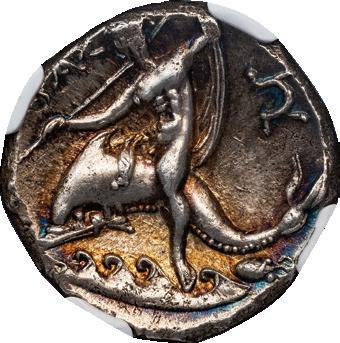
Obv. ΞΕΝΟΚΡΑΤΗΣ, bearded horse rider right, saluting, TK and pileus in upper right field. Rev. TAPAΣ, dolphin rider left, holding trident and his drapery, Σ above, stylized waves below with cuttlefish to the right.
Vlasto 957; HN Italy 1058; SNG ANS 1258.
NGC graded CHOICE AU, Strike 4/5, Surface 3/5, “brushed,” boldly struck with iridescent highlights, popular variety with the cuttlefish symbol.

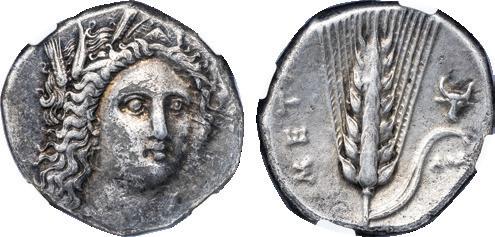
19291. LUCANIA. METAPONTUM. Ca. 330–280 BC.
Silver Stater, 7.69 g, 20 mm.
$ 1275

Obv. Wreathed head of Demeter facing three quarters right, AΠ in right field. Rev. META, ear of barley, facing bull’s head in right field and AΘA below leaf.
Johnston, Metapontum, Class C, 2.2 (same dies); SNG ANS 463–464 (same dies); HN Italy 1584. Ex Economopoulos Numismatics, private sale with old dealer’s tag included.
NGC graded XF, Strike 4/5, Surface 3/5, steel gray toning and of good metal, scarce facing head issue with well–preserved details. $ 875



19388. BRUTTIUM. TERINA. Ca. 300 BC.
Silver Drachm, 2.15 g, 16 mm.
Obv. TEPINAIΩN, head of nymph Terina left, triskeles in right field. Rev. Nike seated left on cippus, holding bird in outstretched right hand, TE monogram in left field.
R. Ross Holloway and G. Kenneth Jenkins, Terina, 112; SNG ANS 859; SNG Copenhagen 2030; SNG Lockett 682. Ex Vinchon Numismatique, 4/11/1988, lot 230 (part of).
NGC graded VF, Strike 5/5, Surface 3/5. $ 1350
5
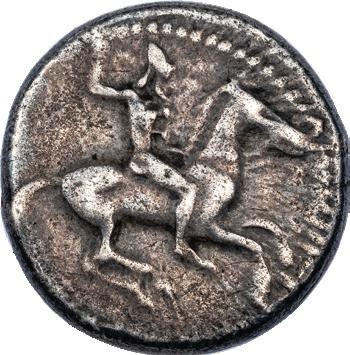
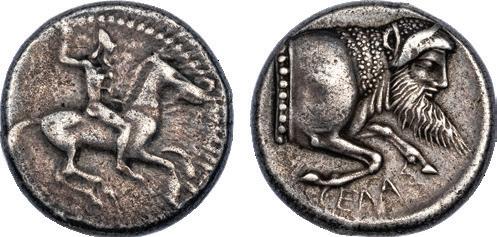
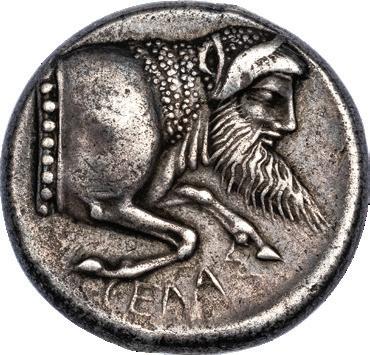
19344. SICILY. GELA. Ca. 490–475 BC.
Silver Didrachm, 8.66 g, 20 mm.
Obv. Nude horseman right, preparing to throw spear. Rev. CEΛAΣ, protome of man–headed bull right. Jenkins, The Coinage of Gela, 60 (O18/R26); HGC 2, 363.
NGC graded CHOICE VF, Strike 4/5, Surface 4/5. $ 4800
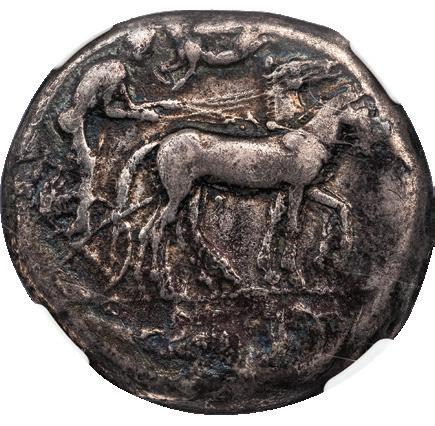

19554. SICILY. SYRACUSE. Ca. 465–460 BC.
Silver Tetradrachm, 16.70 g, 26 mm. Issue of ca. 450-440 BC.

Obv. Charioteer driving biga right, Nike, above, flying left offering diadem to driver, ketos right in exergue. Rev. ΣΥΡΑΚΟΣΙΟΝ, diademed head of Arethusa right, four dolphins around. Boehringer, Syrakus, 489 (V258/R351); HGC 2, 1312. Ex Aaron Morse Collection, Anchorage, Alaska.
NGC graded FINE, Strike 4/5, Surface 3/5, “overstruck.”
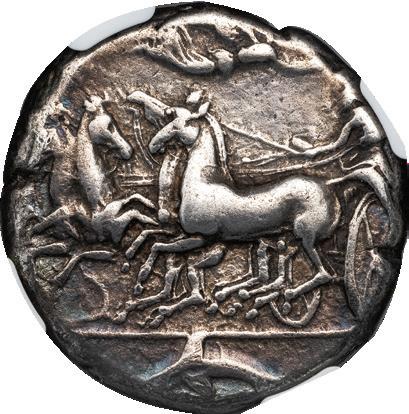
19409. SICILY. SYRACUSE. Ca. 405–385 BC.


Silver Tetradrachm, 17.00 g, 25 mm. Issue of ca. ca. 399–387 BC, struck from unsigned dies in the style of Eucleidas.
$ 850
Obv. Charioteer driving quadriga left, Nike flying above right, crowning driver, dolphin springing left in exergue. Rev. [ΣΥΡΑΚΟΣΙΟΝ], diademed head of Arethusa left, her hair flowing upward as if she was swimming underwater, four dolphins around. Fischer–Bossert, Coins, Artists, and Tyrants, 104 (O35/R71); HGC 2, 1345.
NGC graded VF, Strike 4/5, Surface 4/5, FINE STYLE, slight blue iridescent highlights around the edge, a variety of the famous “underwater Arethusa” type where the nymph appears as if she was swimming beneath the water, her locks undulating in the waves. $ 3500
6


19378. SICILY. SYRACUSE. HIERONYMUS, 215–214 BC.
Silver 10 Litrai, 8.53 g, 22 mm.

Obv. Diademed head of Hieronymus left. Rev. BAΣIΛEΩΣ IEPΩNYMOY, winged thunderbolt, AΦ above.
Holloway, The Thirteen-Months Coinage of Hieronymos of Syracuse, 24 (O11/R21); BMC 643. SNG München 1423. HGC 2, 1567. Ex Edward J. Waddell, inv. 5991, with original tag.
NGC graded CHOICE VF, Strike 4/5, Surface 4/5. $ 3250
Hieronymos was the grandson of the great Hieron II of Syracuse, a dynast who had weathered the vicissitudes of the First Punic War to become the Roman client king over much of Sicily. Unfortunately, Hieronymos was very politically inexperienced when he succeeded his father in 215 BC at the age of fifteen and was quickly caught up in the schemes of his power–hungry uncle and the dangers of the unfolding Second Punic War. Hieronymos entered into an alliance with Hannibal against the Romans, who were still reeling from the disaster of Cannae (216 BC) and raised an army in preparation for war. However, before he could begin campaigning, he was assassinated in 214 BC, while visiting Leontinoi. His murder has been variously attributed to popular outrage at his despotic behavior towards his people or to the actions of the pro–Roman faction in Syracuse.
LYBIAN MERCENARIES VS. CARTHAGE


19092. CARTHAGE. ZEUGITANA. LIBYAN REVOLT, ca. 241–238/7 BC.
Billon Shekel, 9.04 g, 25 mm.

Obv. Head of Heracles left, wearing lion skin. Rev. Lion prowling right, Punic letter M above, ΛΙΒΥΩN in exergue. Carradice & La Niece, “The Libyan War and Coinage,” Numismatic Chronicle 1988, p. 34, no. 1; SNG Copenhagen 239–243. NGC graded AU, Strike 3/5, Surface 4/5, “overstruck,” particularly nice for the type, with minimal traces of the undertype which often disfigures the new design.
The Libyan Revolt of 241–238/7 BC, also known as the Mercenary War, or the Truceless War, was a conflict that erupted between the Punic paymasters of Carthage and some 20,000 North African mercenary troops who had fought in First Punic War (264–241 BC) but remained unpaid at its conclusion. In an effort to exact payment, they besieged Carthage and raised their Libyan home cities in rebellion, but they were ultimately defeated by Hamilcar Barca and their leaders were crucified. Interestingly, while the primary grievance that sparked the revolt was the lack of pay, during the conflict the Libyan mercenaries actually struck their own coinage like the present shekel. However, the evident scarcity of precious metal forced them to produce their coins with heavily debased silver. The legend is notable for naming the Libyans as a unified ethnic group while the depiction of Heracles alludes to his travels in Lydia while seeking out the Garden of the Hesperides and the tradition that he was an ancestor of the Libyan peoples. $ 1950
7

19287. THRACE. MARONEIA. 2nd–1st CENTURIES BC.
Silver Tetradrachm, 16.09 g, 32 mm.
Obv. Wreathed head of young Dionysus right. Rev. ΔIONYΣOY ΣΩTHPOΣ ΜΑΡΩΝΙΤΩΝ, Dionysus standing left, holding grapes and spears, cloak on left arm, control monograms flanking him.
Schönert–Geiss, Die Münzprägung von Maroneia, cf. 1094 (O 39/unlisted reverse die); HGC 3, 1556.
NGC graded CHOICE XF, Strike 5/5, Surface 4/5, boldly struck with iridescent highlights.


19426. KINGDOM OF THRACE. LYSIMACHUS, 305–281 BC.

Silver Tetradrachm, 17.06 g, 30 mm. Early posthumous issue of Cius, Bithynia, ca. 285–275 BC.
Obv. Head of deified Alexander the Great right, with the horn of Ammon. Rev. ΒΑΣΙΛΕΩΣ
$ 1400
Athena enthroned left, holding Nike crowning Lysimachus’ name, ΦΛ monogram in outer left field, ΓE monogram in left field, club right on bottom of throne, grain stalk left in exergue.
Marinescu, Cius, issue 4, cat. 9 (O3/R9), citing specimen in Paris from the same dies (Fonds général 185); Thompson 182; Müller 371 (as Heraclea Pontica); HGC 3, 1750k.
Ex CNG 82, 9/16/2009, lot 359.
NGC graded CHOICE VF, Strike 5/5, Surface 4/5, a rare emission with a very attractive portrait of Alexander.
SEEMINGLY UNIQUE AND UNPUBLISHED EMISSIONS OF CYZICUS

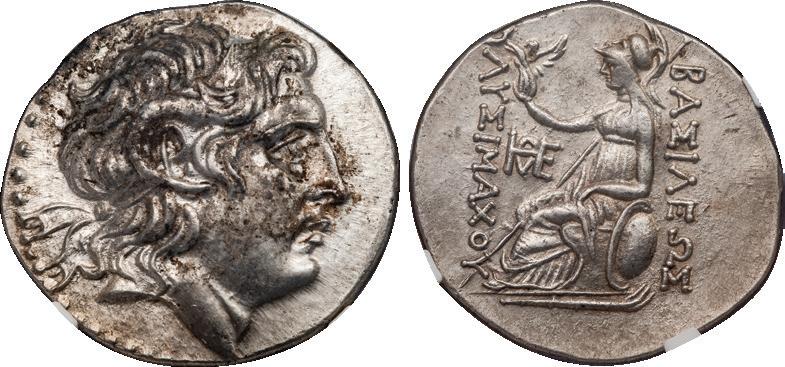
15565. KINGDOM OF THRACE. LYSIMACHUS, 305–281 BC.

Silver Tetradrachm, 16.92 g, 31 mm. Posthumous issue of Cyzicus, Mysia, ca. 200 BC. Obv. Head of deified Alexander the Great right, with the horn of Ammon. Rev. ΒΑΣΙΛΕΩΣ
$ 1850
Athena enthroned left, holding Nike crowning Lysimachus’ name, HD control monogram in left field, torch left in exergue. Müller –; Mektepini Hoard –; ANS Photofile –; CoinArchives –.
NGC graded AU, Strike 5/5, Surface 3/5, “brushed,” “marks,” with some faint remnants of encrustation. This control is apparently unrecorded, with no specimens listed in CoinArchives, the ANS Photofile, or the Mektepini hoard which included many of these emissions. $ 2750
8
ΛΥΣΙΜΑΧΟΥ,
ΛΥΣΙΜΑΧΟΥ,


19068. KINGDOM OF MACEDON. ALEXANDER III, THE GREAT, 336–323 BC.

Silver Tetradrachm, 17.00 g, 26 mm. Early posthumous issue of Corinth struck under Demetrius Poliorcetes, ca. 310–290 BC. Obv. Head of young Heracles right in lion skin headdress. Rev. ΑΛΕΞΑΝΔΡΟΥ, Zeus enthroned left, holding eagle and scepter, Nike standing right, holding palm and offering wreath in left field, ΔO monogram above throne strut.
Price 675; Newell, The Alexander Coinage of Sicyon, 22.3.
Ex Sedwick Auction 12, 10/25/2012, lot 1220.
NGC graded XF, Strike 5/5, Surface 3/5, extremely interesting and complex symbol.
RHODIAN ALEXANDER VARIETY WITH CITY NAME REMOVED


19157. KINGDOM OF MACEDON. ALEXANDER III, THE GREAT, 336–323 BC.

$ 1450
Silver Tetradrachm of Alexander type, 30 mm. Posthumous issue of Rhodes, ca. 205–190 BC, struck by magistrate Teisylos. Obv. Head of young Heracles right in lion skin headdress. Rev. ΑΛΕΞΑΝΔΡΟΥ, Zeus enthroned left, holding eagle and scepter, TEIΣYΛOΣ above rose in left field, PO ethnic ERASED FROM DIE below throne.
Cf. Price 2520 (with PO on throne); Kleiner, “The Alexander Tetradrachms of Pergamum and Rhodes,” Series XI, obv. die Z; HGC 6, 1455.
NGC graded CHOICE VF, a very interesting variety of a scarce magistrate, the seemingly intentional removal of the city’s abbreviated name is puzzling. $ 850
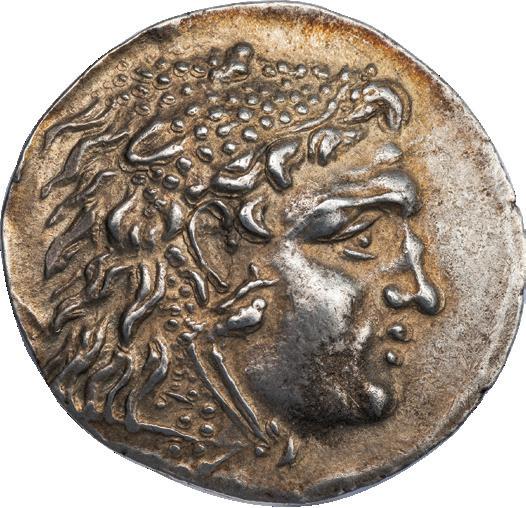
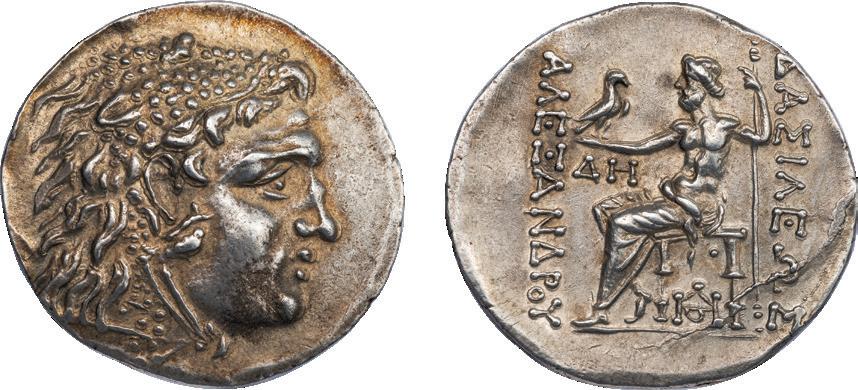
17302. KINGDOM OF MACEDON. ALEXANDER III, THE GREAT, 336–323 BC. Silver Tetradrachm, 16.49 g, 33 mm. Posthumous issue of Odessus, Thrace, ca. 120–90 BC.
Obv. Head of young Heracles right in lion skin headdress. Rev. ΒΑΣΙΛΕΩΣ

Zeus enthroned left, holding eagle and scepter, ΔH in left field, OΔH monogram below throne. Price 1179.
NGC graded AU, Strike 5/5, Surface 3/5, die crack on reverse, well struck with golden iridescence.
$ 950
9
ΑΛΕΞΑΝΔΡΟΥ,



18505. KINGDOM OF MACEDON. ALEXANDER III, THE GREAT, 336–323 BC.
Silver Tetradrachm, 17.15 g, 27 mm. LIFETIME issue of Babylon, ca. 325–323 BC.

Obv. Head of young Heracles right in lion skin headdress. Rev. ΑΛΕΞΑΝΔΡΟΥ, Zeus enthroned left, holding eagle and scepter, kylix in left field, monogram above M below throne.
Price 3654.
Ex Salton Collection, likely acquired in the 1950s–1960s when Mr. Salton owned a numismatic firm in New York.
NGC graded XF, Strike 3/5, Surface 4/5, “overstruck.”
This is an extremely interesting and perplexing coin since it appears to be a late lifetime tetradrachm of Alexander the Great from the mint of Babylon that has been overstruck on another tetradrachm of Alexander with the same imperial types of Heracles and Zeus. Traces of the host coin’s reverse type (the shoulder and arm of Zeus holding his scepter) are visible above the eye of Heracles on the obverse while traces of the host’s obverse type (the face of Heracles are visible behind Zeus on the reverse. The question is what purpose could there have been in overstriking the same types? As a lifetime issue the only host coins available would have been other, earlier lifetime Alexander tetradrachms and these seem to have been able to circulate throughout Alexander’s empire. Perhaps there is some administrative explanation that is now obscure. It is definitely a coin worthy of further research. $ 1450


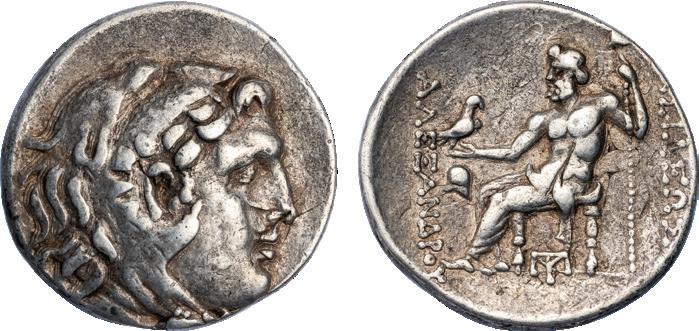
18132. KINGDOM OF MACEDON. ALEXANDER III, THE GREAT, 336–323 BC.

Silver Tetradrachm, 16.37 g, 28 mm. Posthumous issue of Mesembria, Thrace, ca. 225–200 BC. Obv. Head of young Heracles right in lion skin headdress. Rev. ΒΑΣΙΛΕΩΣ ΑΛΕΞΑΝΔΡΟΥ, Zeus enthroned left, holding eagle and scepter, helmet in left field, ΠXI monogram below throne. Price 1011; American Numismatic Society 1944.100.35754 (same reverse die, in a more advanced state of wear).
NGC graded VF, Strike 4/5, Surface 4/5, “overstruck.” An extremely rare emission, with only one specimen on CoinArchives and the ANS specimen cited above that is listed in Price as well as the Pella database. Even more interesting is that this piece is overstruck on a tetradrachm of Lysimachus. While the exact variety is not clearly discernible, Athena’s arm resting on her shield from the undertype’s reverse is visible on the reverse of the present specimen. $ 1975
This extremely rare issue is of special interest for the history of coin production at Mesembria. In his treatment of overstriking at this city, David MacDonald noted 11 examples in the period c. 225–175 BC and three in the period c. 175–150 BC (D. MacDonald, Overstruck Greek Coins, Whitman 2009, p. 119). Of these, all were overstruck on earlier Alexander tetradrachms produced elsewhere, except for one of the second overstriking period (no. 96) that was struck over a posthumous Lysimachus tetradrachm of Byzantium. The present coin, however, was struck over a Lysimachus tetradrachm in the first period of overstriking, thereby making it the earliest known example of an overstruck Lysimachus type at Mesembria. While there are not enough remaining details of the host coin to identify the mint, the regional importance of Byzantium as a producer of posthumous Lysimachus tetradrachms makes it seem not improbable that the host coin was struck there.
10
TWO OVERSTRUCK ALEXANDER TYPE TETRADRACHMS

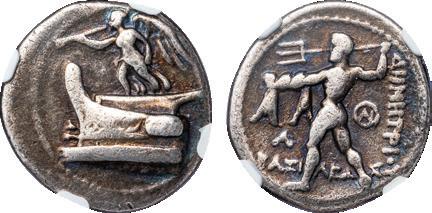
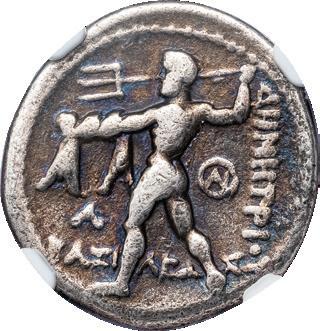
19512. KINGDOM OF MACEDON. DEMETRIUS POLORCETES, 306–283 BC.
Silver Drachm, 4.05 g, 18 mm. Issue of Tarsus, ca. 298–295 BC.
Obv. Nike on prow of ship, blowing trumpet. Rev. ΒΑΣΙΛΩΣ ΔΗΜΙΤΡΙOΥ, Poseidon striding left, preparing to throw trident, A in left field, AIO monogram in right field.
Newell 44.
Ex CNG ESale 482, 12/16/2020, lot 80.
Ex Private Collection, Phoenix, Arizona, acquired from Vilmar Numismatics LLC in July, 2021.
NGC graded FINE, Strike 5/5, Surface 4/5, iridescent toning. $ 750
Demetrius “the Besieger” was one of the more colorful players in the struggle for power following Alexander’s death. His coinage features Poseidon, god of the sea, recalling Demetrius’ claims to glory as being a “Besieger of Cities.” This series depicts a triumphal monument commemorating a naval victory, with Nike, goddess of Victory, blowing a trumpet from the prow of a ship. It recalls the “Victory of Samothrace,” the famous statue in the Louvre Museum that comes from a similar monument.
FROM THE COLLECTION OF NELSON BUNKER HUNT AND EX NFA 1981


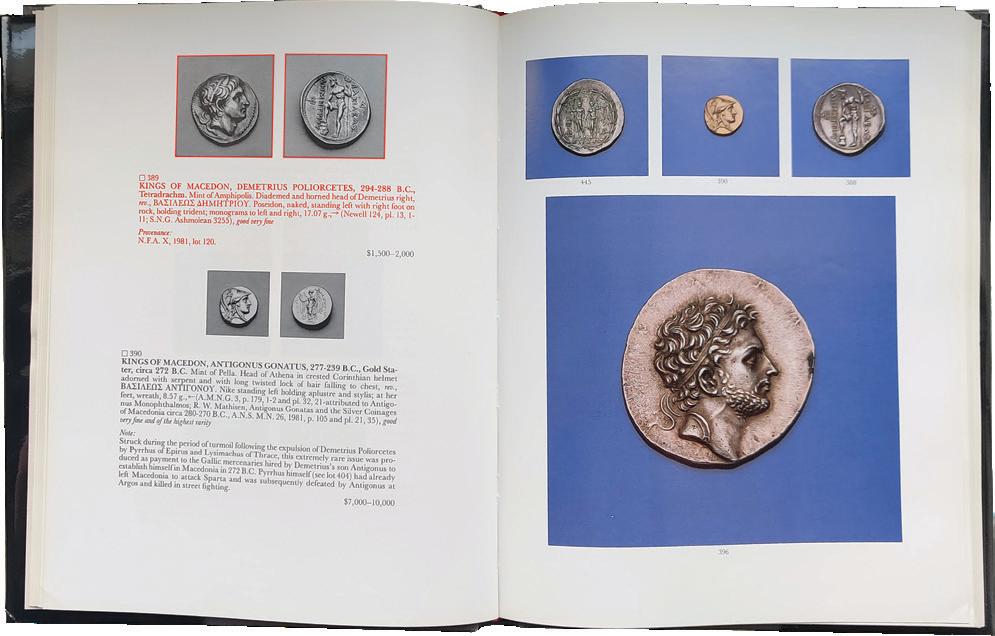

19347. KINGDOM OF MACEDON. DEMETRIUS POLORCETES, 306–283 BC.
Silver Tetradrachm, 17.07 g, 32 mm. Issue of Amphipolis, ca. 289–288 BC.
Obv. Diademed and horned head of Demetrius right. Rev. ΒΑΣΙΛΩΣ ΔΗΜΙΤΡΙOΥ, Poseidon standing left with foot placed on rock, holding trident, control monograms in outer left and outer right fields.
Newell 124 (obverse die CXXII); HGC 3, 1014b.
Ex Edward J. Waddell, Ltd. Inv. 45780 (with tag) = Leu 61, 5/17/1995, lot 110 = Nelson Bunker Hunt Collection, Part II, Sotheby’s New York, 6/21/1990, lot 389 = Numismatic Fine Arts X, 9/17/1981, lot 120.
NGC graded XF STAR, Strike 5/5, Surface 5/5, iridescent toning, a coin with an exceptional portrait of Demetrius. $ 7850
11


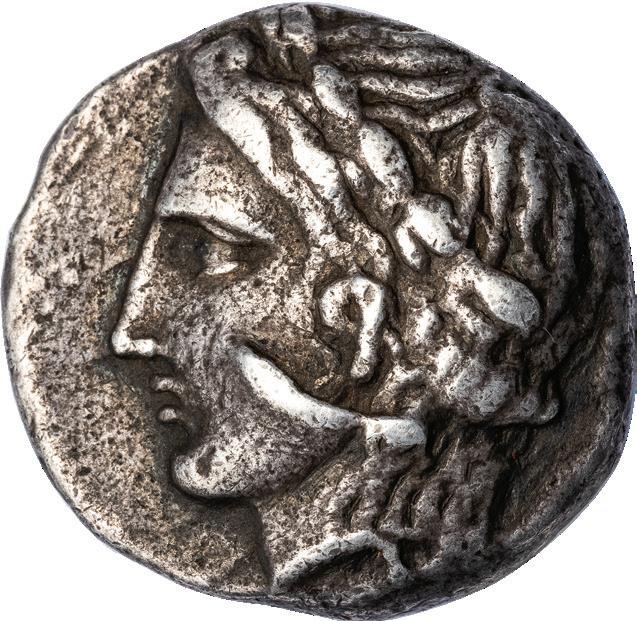



19514. ILLYRIA. DAMASTIUM. Ca. 400–345 BC. Silver Tetradrachm, 11.30 g, 24 mm.
Obv. Laureate head of Apollo left. Rev. ΔΑΜ[ΑΣ]–[ΤΙ]ΝΩΝ, flanking tripod with lion feet. May, The Coinage of Damastion, 85 (this coin listed and illustrated); HGC 3, 90.
Ex CNG 38, 6/6/1996, lot 257 (with original tag) = Naville Ars Classica X, 6/15/1925 (collections of a “grand industriel décédé,” baron Alexandre de Petrowicz, Rev Edgar Rogers, and others), lot 532.
NGC graded CHOICE VF, Strike 4/5, Surface 4/5, “edge scuffs,” May publication data and Naville provenance listed on label. $ 5000
12
DAMASTIUM
PEDIGREED
TETRADRACHM PLATED IN MAY AND EX ARS CLASSICA X SALE OF 1925
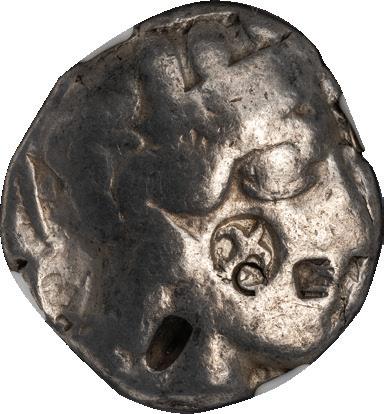


11845. ATTICA. ATHENS. Ca. 440–404 BC, POSSIBLY COUNTERMAKED IN JERUSALEM.
Silver Tetradrachm, 25 mm.
Obv. Helmeted head of Athena right. Rev. ΑΘΕ, owl standing right, head facing, olive sprig and crescent in left field, all within incuse square.
Kroll 8; SNG Copenhagen 31; Dewing 1591–1598. For these Levantine countermarks in general see Peter Van Alfen, AJN 14 (2002), pp. 4 ff., and T.V. Buttrey in Proceedings of the 9th International Congress of Numismatics, Berne (1979), vol. I, Louvain–la–Neuve (1982), pp. 137–140, pl. 21, 3 (style M) who discuss more on attribution.
NGC graded VG, “test cuts,” “countermarks,” the lily countermark on obverse, a variety of other countermarks, punch marks or tests cuts on the reverse.
The lily was the symbol of Jerusalem and appears early on in its fourth century Persian–period Yehud coinage and continues as a prominent symbol of the city on later Hasmonean and Seleucid emissions as well. Although it is not certain that the lily countermark was applied in Jerusalem, it is undoubtedly connected in some way to that area, whether it is the mark of the city itself or of a man who originated there and appropriated it as his own badge. It certainly was applied in the general geographical area as the Athenian tetradrachms on which it is found circulated in the Levant, in the regions encompassing the modern states of Israel, Lebanon and Egypt.


18530. PAPHLAGONIA. SINOPE. Ca. LATE 4th CENTURY BC.
Silver Drachm, 6.08 g, 19 mm. Issue of magistrate Phagetas.
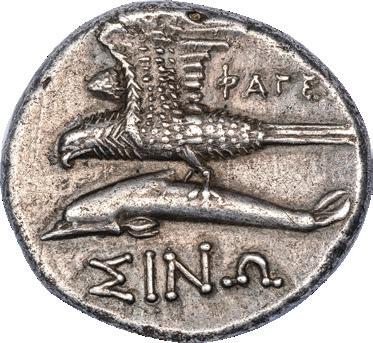
Obv. Head of nymph Sinope left, wearing saccos. Rev. ΣΙΝΩ, sea eagle holding dolphin left, ΦΑΓΕ[TA] in right field.
SNG British Museum Black Sea 1479; HGC 7, 391 Ex Salton Collection, acquired from Numismatic Fine Arts IX, 12/10/1980, lot 228.
$ 650
NGC graded CHOICE XF, Strike 5/5, Surface 5/5, NFA provenance noted on holder. $ 1450


18371. BITHYNIA. HERACLEA PONTICA. Ca. 550–500 BC.
Electrum Hecte, 2.58 g, 12 mm.

Obv. Head of Heracles left in lion skin headdress. Rev. Quadripartite incuse square. Wolfgang Fischer–Bossert, “Die Elektronhekten mit dem Herakleskopf: Herakleia Pontike, nicht Erythrai,” Numismatische Zeitschrift 126 (2020), Group 10, cf. 55 (possibly obverse 26).
NGC graded AU, Strike 4/5, Surface 5/5. $ 2450
This series, formerly attributed to Erythrae in Ionia, has now been assigned to Heraclea Pontica by Fischer–Bossert who published a die study in 2020. NGC continues to use the old attribution of Erythrae on its labels.
13
?
COUNTERMARKED IN JERUSALEM

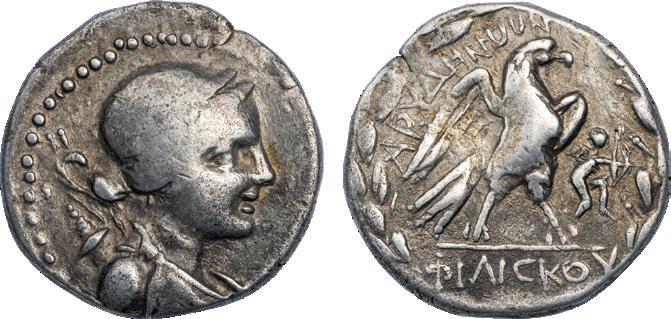
18658. TROAS. ABYDUS. 2nd–1st CENTURIES BC.
Silver Tetradrachm, 16.08 g, 27 mm. Issue of magistrate Philiscus.
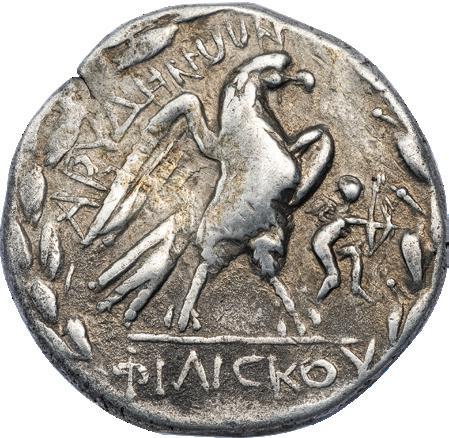
Obv. Draped bust of Artemis right, her bow and quiver over shoulder. Rev. ABYΔHNΩN, eagle standing right, Eros shooting bow in right field, ΦIΛICKOY in exergue, all within laurel wreath. F. de Callataÿ, “Abydos sur Aesillas” in Essays Oeconomides, p. 87, D23/R1 (citing one example in Oxford).
NGC graded CHOICE FINE, Strike 4/5, Surface 4/5, exceedingly rare magistrate issue, seemingly the only one known aside from the coin cited by de Callataÿ. $ 1500
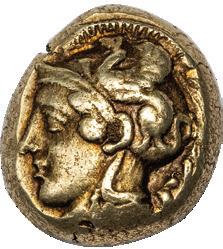
19404. LESBOS, MYTILENE. Circa 477–388 BC.
Electrum Hecte, 2.54 g, 11 mm.

Obv. Helmeted head of Athena left. Rev. Quadripartite incuse square. Bodenstedt 91.
Ex Buddy Ebsen collection, Superior 7, 6/7/1987, lot 4132.
NGC Graded CHOICE XF Strike 5/5, Surface 4/5.

19274. IONIA. EPHESUS. Ca. 394–325 BC.

2500


Silver Tetradrachm, 15.18 g, 24 mm. Issue of magistrate Ippocritus, ca. 360–350 BC. Obv. E – Φ, bee seen from above. Rev. Forepart of stag right, palm tree at left, IΠΠOKPITOΣ (magistrate) in right field. Kinns, Pixodarus, Class F, p. 203, obverse 96.
NGC graded CHOICE XF, Strike 5/5, Surface 4/5, a beautiful coin with full detail on the bee.

19155. IONIA. EPHESUS. Ca. 394-325 BC.
Silver Tetradrachm, 14.97 g, 24 mm. Issue of magistrate Chairites, ca. 340-325 BC.
$ 5750
Obv. E – Φ, bee seen from above. Rev. Forepart of stag right with wreath on chest, palm tree at left, XAIPITHΣ (magistrate) in right field. Kinns, Pixodarus, Class I, pp. 182-183, obverse 144. Kinns cites only two specimens.
NGC graded CHOICE VF, Strike 4/5, Surface 4/5, extremely rare magistrate variety.
$ 2250
14
$





19546. LYDIA. ALYATTES OR WALWET. Ca. 610–546 BC.
Electrum Hemihecte (1/12 stater), 1.14 g, 7 mm. Uninscribed issue of Sardes.
Obv. Head of roaring lion right, “sun disk” on forehead. Rev. Incuse punch with two sections. Linzalone LN1091; Weidauer 90.
NGC graded CHOICE FINE, Strike 5/5, Surface 2/5, “countermarks”; three small countermarks (“banker’s marks”) were applied here on the obverse and edge of the coin. $ 850
extremely rare countermarked croesus siglos

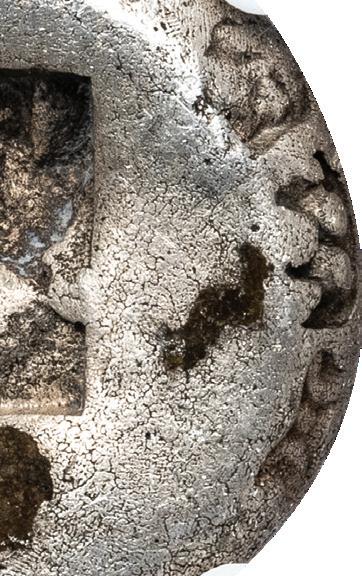
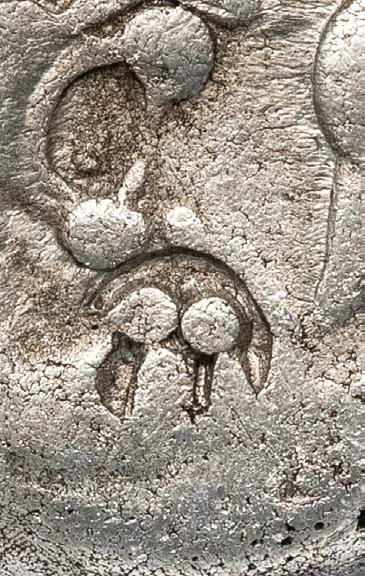

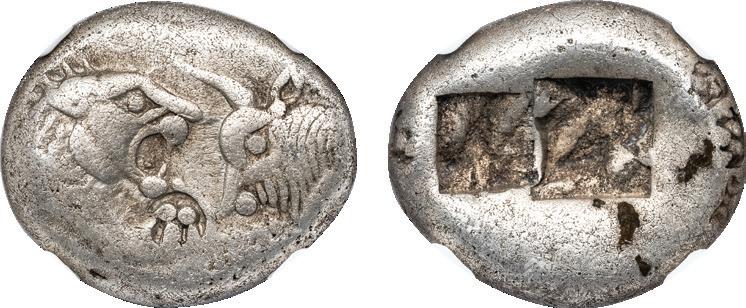
19135. LYDIA. CROESUS, 561–546 BC.
Siver Siglos (half stater), 5.14 g, 16 mm
Obv. Forepart of roaring lion right confronting forepart of bull left. Rev. Two incuse punches. Berk 23; SNG Kayhan 1025; SNG von Aulock 2877–2879.
NGC graded VF, Strike 5/5, Surface 2/5, “countermarks.” $ 1950
This is an exceptional specimen featuring several countermarks, a rarity for the silver Croesus series. The most prominent of these appears on the obverse of the coin and may be intended to illustrate a lion’s paw. Additionally, there are 3 more countermarks on the edge of the coin, including one that shows a male head, seemingly wearing a Persian cap and thus possibly meant to be the Persian king or a satrap. I am unaware of this countermark on other Croesus silver coins.
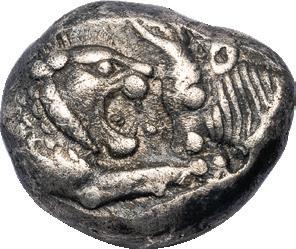


19484. LYDIA. CROESUS, 561–546 BC.
Siver Hecte, 1.75 g, 11 mm.
Obv. Forepart of roaring lion right confronting forepart of bull left. Rev. Two incuse punches. Berk 25; SNG Ashmolean 773.
NGC graded CHOICE XF, Strike 5/5, Surface 4/5. $ 1250
15
THE
While Seleucus II struggled to defend the Seleucid empire against Ptolemy III Euergetes during the Third Syrian War (246–241 BC), his mother placed his younger brother, Antiochus, in charge of Asia Minor. Once the war with Ptolemy ended, Antiochus refused to give up his power in Asia and successfully fought the War of the Brothers (ca. 240/39–237 BC) to prevent Seleucus II from reclaiming it. Antiochus’ grasping character and his frequent use of rapacious Galatian mercenaries earned him the nickname, Hierax, meaning “the Hawk.” Unfortunately, the propensity of the Galatians for plunder and his frequent inability to control their depredations made Antiochus Hierax unpopular and allowed Attalus I of Pergamon to gain increasing influence as a potential savior of the Greek cities. After a series of defeats, in 228 BC Hierax was expelled from Asia Minor. He then made a failed attempt to supplant his brother, Seleucus II, in Mesopotamia before withdrawing to Thrace. Having tired of his long losing streak, the Galatian mercenaries in Hierax’s employ finally turned against their paymaster and killed him in ca. 226 BC.
During his troubled reign, Antiochus Hierax struck silver tetradrachms at a variety of mints in western Asia Minor—especially at Lysimacheia in Thrace and in coastal cities of Mysia and Troas, where his power seems to have been centered and his conflict with Attalus I most acute. Mints in Phrygia are almost certainly connected to the War of the Brothers, and the campaigns that culminated in Hierax’s victory over Seleucus II at the Battle of Ancyra (c. 239 BC). His tetradrachms are notable for their frequent use of portraits that are difficult to identify, many of which have been thought to be resurrected and rejuvenated portraits of Antiochus I. It is not clear whether civic political motivations may lie behind the apparent obfuscation of Hierax’s personal image as they found themselves caught in the middle of the struggle between Antiochus Hierax and Attalus I for dominance in Asia Minor. The reverses of Hierax’s tetradrachms, regularly feature the traditional Seleucid dynastic Apollo type to advertise his legitimacy despite his rather dubious claim to the kingship.

16
COINAGE OF ANTIOCHUS HIERAX – “THE HAWK”

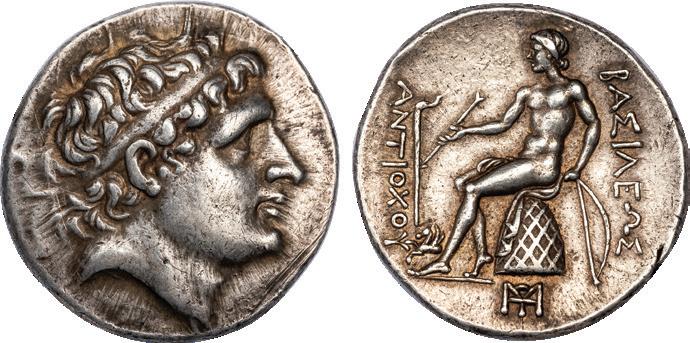





19493. SELEUCID KINGDOM. ANTIOCHUS HIERAX, ca. 242–227 BC. Silver Tetradrachm, 17.10 g, 29 mm. Obv. Diademed head of Antiochus I to right. Rev. BAΣIΛEΩΣ ANTIOXOY, Apollo seated left on omphalos, holding arrow in right hand and resting left on grounded bow, long torch and small forepart of Pegasus in left field, MYT control monogram in exergue. SC 848.3b (this coin plated). HGC 9, 399c (this coin illustrated). Ex W. Wahler collection, Numismatic Fine Arts XXXIII, 5/3/1994, 273. NGC graded XF, Strike 5/5, Surface 3/5, “marks,” SC and HGC pedigrees listed on label. a piece twice selected as a plate coin in major publications on Greek numismatics, as well as a rare variety with only 10 other specimens on CoinArchives.
This rare piece is an exceptionally attractive example of the tetradrachm coinage of Antiochus Hierax, which does not always reach the highest level of execution. In this case, however, it is obvious why this coin is so frequently illustrated. Although struck from a slightly used die, the obverse features a powerful example of a posthumous Antiochus I portrait while the sharply struck reverse features an impressive rendition of the Seleucid Apollo type. The forepart of Pegasus on the reverse is a civic badge of Lampsacus that had been in use since at least the fifth century BC. The long torch symbol is also found on tetradrachms struck at the nearby city of Abydus, pointing to the sharing of coin production between the two cities. $ 5750
17
PLATED IN “SELEUCID COINS” AND “HANDBOOK OF GREEK COINS”

19415. SELEUCID KINGDOM. ANTIOCHUS HIERAX, ca. 246–227 BC.
Silver Tetradrachm, 16.86 g, 31 mm. Issue of Parium.
Obv. Diademed head of young king right, probably Antiochus Hierax. Rev. BAΣIΛEΩΣ ANTIOXOY, Apollo seated left on omphalos, holding arrow in right hand and resting left on grounded bow, Pan head and bull butting right in exergue.
SC 836.3; Seyrig, Parion 28 (dies III/D’); HGC 9, 403a.
NGC graded AU, Strike 5/5, Surface 4/5. $ 3200

19416. SELEUCID KINGDOM. ANTIOCHUS HIERAX, ca. 242–227 BC.
Silver Tetradrachm, 16.88 g, 29 mm. Issue of Ilium.
Obv. Diademed head of idealized king right, with heavy features and slightly aquiline nose, perhaps a portrait of Antiochus I. Rev. BAΣIΛEΩΣ ANTIOXOY, Apollo seated left on omphalos, holding arrow in right hand and resting left on grounded bow, round shield in outer left field.
SC 869.1; HGC 9, 405f; Bellinger, Troy T20.
NGC graded AU, Strike 5/5, Surface 3/5, “FINE STYLE.” $ 2800
The shield symbol on the reverse may perhaps represent the legendary shield of Achilles—the greatest Greek hero of the Trojan War fought at Ilium. This ornate defensive weapon was created by Hephaestus at the request of Achilles’ mother, Thetis, and is described in great detail in Homer’s Iliad (book 18, lines 478–608).
PREVIOUSLY UNKNOWN AND UNPUBLISHED TRANSITIONAL VARIETY OF WORKSHOP B AT ALEXANDRIA TROAS

19367. SELEUCID KINGDOM. ANTIOCHUS HIERAX, ca. 242–227 BC.
Silver Tetradrachm, 16.93 g, 29 mm. Issue of Alexandria Troas. Obv. Diademed head of a rejuvenated Antiochus I right. Rev. BAΣIΛEΩΣ ANTIOXOY, Apollo seated left on omphalos, holding arrow in right hand and resting left on grounded bow, horse grazing right in exergue. SC unlisted, but probably a Workshop B issue.
Ex Peus 393, 10/31/2007, lot 289. NGC graded CHOICE XF, Strike 5/5, Surface 2/5, “brushed,” “scuffs,” “edge bend,” “unlisted in SC” noted on label. $ 2750
This coin, a variety unknown to the authors of SC, should probably be considered a transitional issue between Series I and Series II of Workshop B. Its left field control occurs on SC 875.9 (Workshop A, inner left field), 878.4 (Workshop B, exergue), and 822.6 (Workshop B, outer left). The right field control occurs on SC 882.2 and 882.4 (Workshop B, outer left). While the controls seem to point to SC Workshop B, Series II, Group B, Apollo’s drapery, and the pellets on the bow grip are features of Workshop B, Series I, Group B, thus making this a likely “transitional” variety.
18

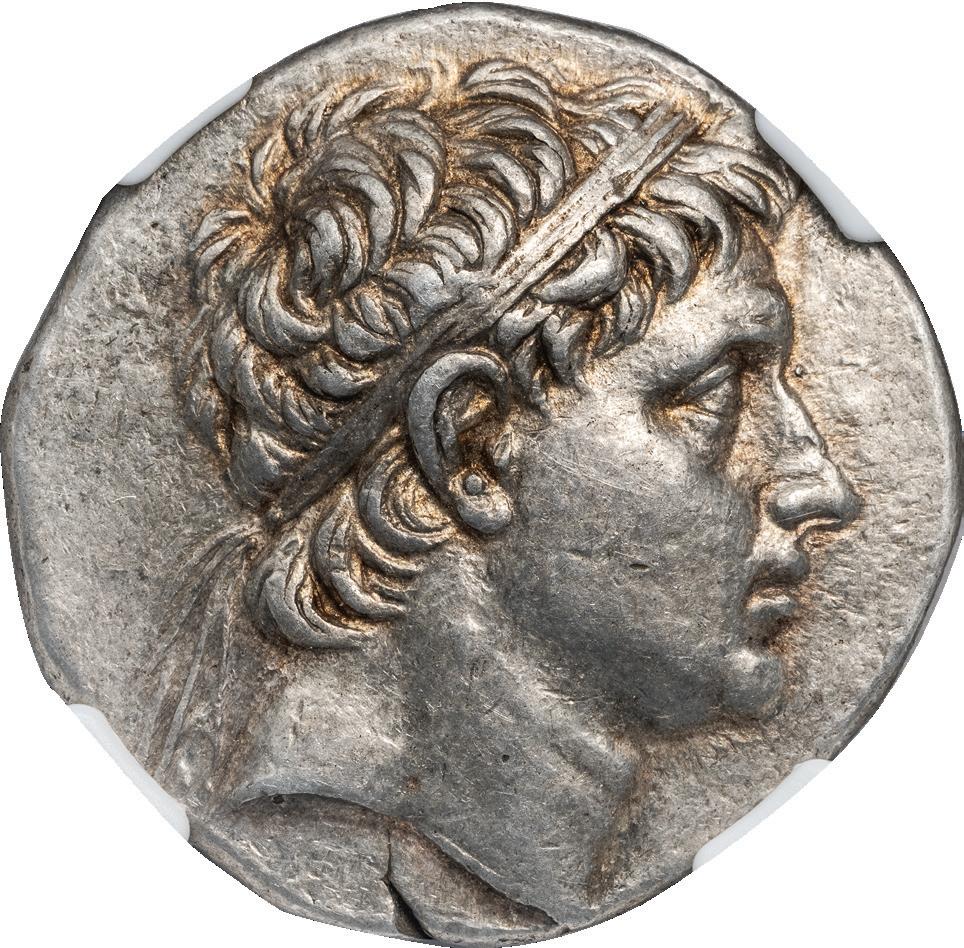


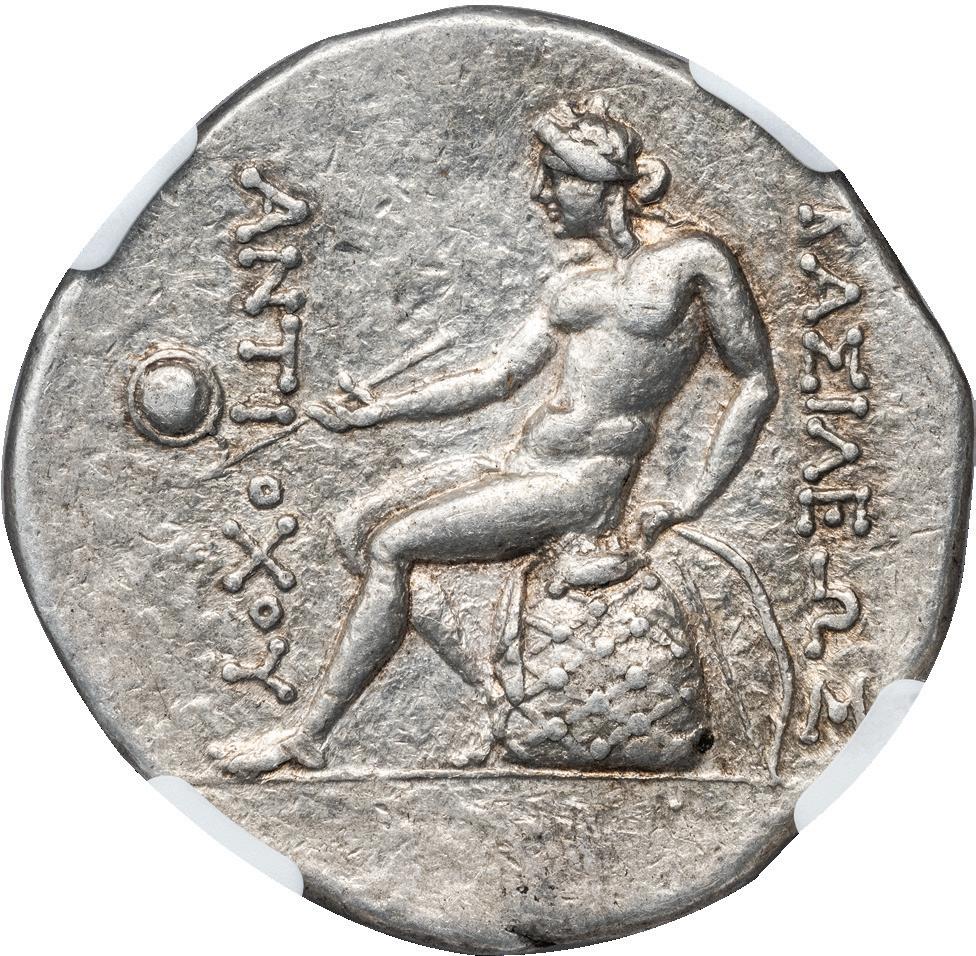

19



19330. PHOENICIA. TYRE.
Silver Shekel, 14.09 g, 28 mm. Issue of Tyre year 52 (75/4 BC).
Obv. Laureate head of Melkart right. Rev. ΤΥΡΟΥ
eagle standing left on prow, BN (date) and club in left field, AY monogram in right field, Phoenician letter B between legs.
DCA Tyre Supplement Release 2, 185 var (different letter below eagle).
NGC graded CHOICE VF, Strike 5/5, Surface 4/5, a rare year with only 7 other specimens recorded on CoinArchives. $ 2300

17791. PHOENICIA. TYRE.


Silver Shekel, 13.43 g, 26 mm. Issue of Tyre year 129 (AD 3/4), struck during the LIFETIME OF CHRIST.
Obv. Laureate head of Melkart right. Rev. ΤΥΡΟΥ
eagle standing left on prow, PKΘ (date) above club in left field, KP above monogram in right field, Phoenician letter A? between legs.
DCA Tyre Supplement Release 2, 463 (or 465).
NGC graded FINE, Strike 5/5, Surface 3/5, extremely rare date with CoinArchives listing only 7 other specimens of year 131; being struck AD 3/4, and given its well–worn state, this piece clearly circulated for the entire span of Christ’s lifetime. $ 1450
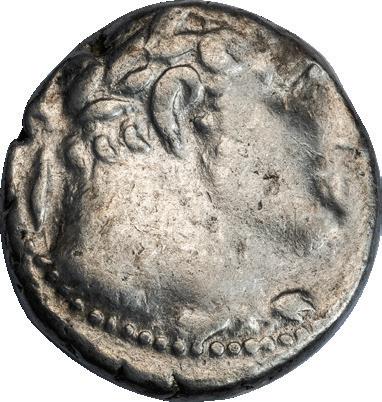


17699. PHOENICIA. TYRE.
Silver shekel, 13.76 g, 24 mm. Issue of Tyre year 143 (AD 17/8), struck during the LIFETIME OF CHRIST.
Obv. Laureate head of Melkart right. Rev. ΤΥΡΟΥ
eagle standing left on prow, PMΓ (date) above club in left field, KP above ΔIOC monogram in right field, Phoenician letter B between eagle’s legs.
Tyre Supplement Release 2, 505.
NGC graded VF, Strike 3/5, Surface 3/5, an extremely rare year variety with the ΔIOC control monogram struck during the lifetime of Christ. $ 2100
20
ΙΕΡΑΣ ΚΑΙ ΑΣΥΛΟΥ,
ΙΕΡΑΣ ΚΑΙ ΑΣΥΛΟΥ,
ΙΕΡΑΣ ΚΑΙ ΑΣΥΛΟΥ,

19468. JUDAEA. JEWISH WAR, 66–70 CE.

Silver Shekel, 14.01 g, 21 mm. Issue of year 3 (68/9 CE).

Obv. [SHEKEL OF ISRAEL / YEAR 3] (paleo–Hebrew), chalice with rim of eight pearls. Rev. [JERUSALEM THE HOLY] (paleo–Hebrew), staff with three pomegranate buds.
Deutsch 20 (O3/R18), listing only one specimen from this die pairing; Hendin 6th edition, 6387.
From the estate of Robert Haber, acquired mostly in the 1980s–early 2000s.
NGC graded CHOICE XF, Strike 5/5, Surface 3/5, “edge chip.”

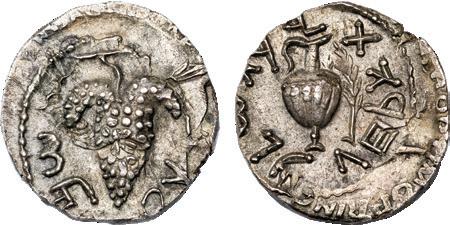
19393. JUDAEA. BAR KOKHBA REVOLT, 132–135 AD.
Silver Zuz, 3.63 g, 19 mm. Undated issue of year 3 (134/5 CE).

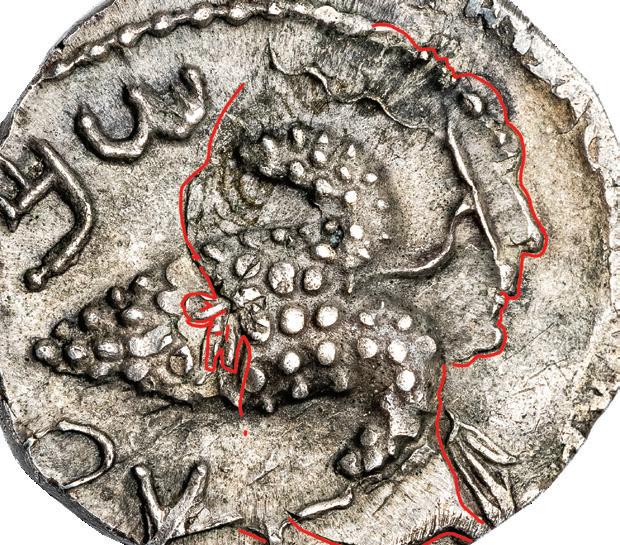
Obv. [SIMON] grape bunch hanging from vine. Rev. [FOR THE FREEDOM OF JERUSALEM], jug and palm branch. Mildenberg 156 (O11/R58’); Hendin 6th edition, 6461. Overstruck on a denarius of Trajan (RIC 142).
NGC graded CHOICE AU, Strike 3/5, Surface 5/5, “undertype: Trajan denarius.”
$ 7500
The undertype is particularly clear here, with the emperor’s face and draped bust on the reverse and part of the original legend preserved on the obverse edge “… [SPQ]R OPTIMO PP IMP...” Also visible next to the legend is a pointed tip, probably the upper part of the bundle of canes held by Arabia as an attribute. Therefore, it seems almost certain that the undertype is a denarius depicting Arabia (RIC 142), a particularly rare type. $ 3250
UNDATED YEAR 3 ZUZ PLATED IN HENDIN’S FIRST EDITION AND PUBLISHED IN MILDENBERG


19394. JUDAEA. BAR KOKHBA REVOLT, 132–135 CE.
Silver Zuz, 2.89 g, 20 mm. Undated issue of year 3 (134/5 CE).
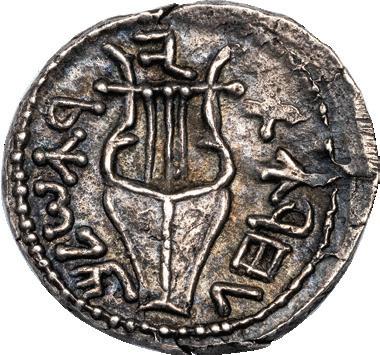
Obv. [SIMON], grape bunch hanging from vine. Rev. [FOR THE FREEDOM OF JERUSALEM], lyre. Mildenberg 204 (O24/R132, 204.37 “D. Hendin coll., 2.85 g”); Hendin 6th edition, 6462; Hendin 1st edition (Guide To Ancient Jewish Coins), 172 (this coin illustrated on plate 6).
Ex Zuzim Inc, formerly in the VJM Collection and purchased from David Hendin in 1976 (according to small tag included).
NGC graded AU, Strike 4/5, Surface 4/5, “overstruck.” Some traces of the undertype and its legend are visible on the obverse. The information that accompanies the coin indicates that it was acquired from David Hendin in 1976 for $ 1900 and cites the Mildenberg reference specifically as 204.37. The somewhat low weight matches almost exactly Mildenberg no. 204.37. Given that 204.37 belonged to David Hendin, and its low weight matches almost exactly that of the present piece, it is certain this is the same coin published in Mildenberg. $ 2950
21



19547. PERSIA. ACHAEMENID EMPIRE. Ca. 485–420 BC.
Gold daric, 8.35 g, 14 mm. Issue of Sardes.
Obv. King running right, wearing tall turreted crown, carrying bow and spear, small quiver on shoulder. Rev. Incuse punch. Carradice Type IIIb, group A/B (pl. XIII, 27); Meadows, Administration, 321; BMC Arabia, pl. XXIV, 26; Sunrise 24.
NGC graded CHOICE XF, Strike 5/5, Surface 4/5, struck perfectly centered, on a particularly attractive round planchet.
$ 3500
FROM MORTAL TO IMMORTAL - THE DEIFICATION OF THE PTOLEMAIC LINE

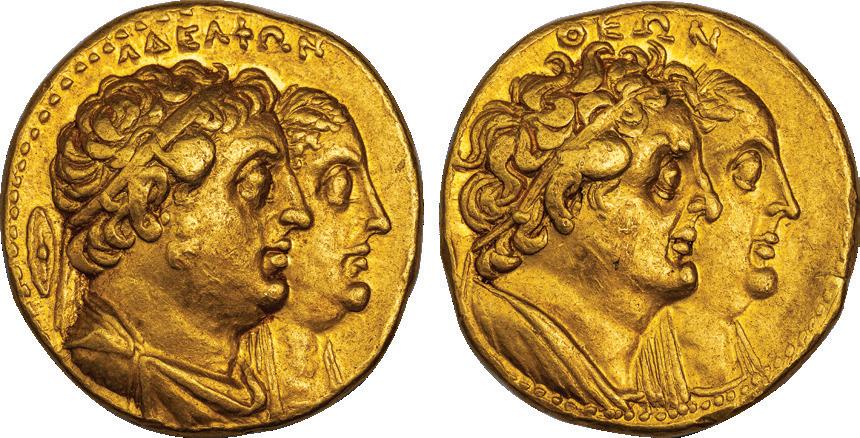


19353. EGYPT, PTOLEMAIC KINGDOM. PTOLEMY II, 285–246 BC.
Gold Mnaieion (Octodrachm) of the “Dynastic” type, 27.67 g, 27 mm. Issue of Alexandria, ca. 272–261/0 BC. Obv. AΔEΛΦΩN, draped busts of Ptolemy II and Arsinoe II right, Ptolemy with diadem, Arsinoe with diadem and veil, shield in left field. Rev. ΘEΩN, draped busts of Ptolemy I and Berenike I right, Ptolemy with diadem, Berenike with diadem and veil. CPE 313; Svoronos 603; Olivier & Lorber, “Three gold coinages of third–century Ptolemaic Egypt” in RBN 159 (2013), 121 (Obv 14/ Rev 49).
NGC graded XF, Strike 5/5, Surface 3/5, “edge marks,” “lt. graffito.” $ 18750
The gold portrait staters of Ptolemy II were probably struck in large part to serve as donative payments for the soldiers that fought in the many armed conflicts of his reign: his struggle against Magas, the rebel governor of Cyrene, campaigns into Nubia, the Chremonidean War (267–261 BC), and two Syrian Wars against the Seleucids (274–271 and 260–253 BC). However, while the primary purpose of their production may have been military, their types were devoted to advertising the legitimacy of his reign and to obliquely defending Ptolemy II’s incestuous marriage to his sister, Arsinoe II. The obverse features the portraits of their parents, Ptolemy I Soter and his wife, Berenice I, with enormous eyes and with an associated legend indicating their deification. While it was normal for native Egyptians to understand the Pharoah as a god, this coin presents the deification of Ptolemy II’s parents for the Greek audience. The reverse in turn depicts Ptolemy II and Arsinoe II in the same style as their father and mother, thus introducing them as royal successors and heirs to the divinity of Ptolemy I and Berenice I. Supposed divinity was the argument used by Ptolemy II to make his marriage to his sister seem less offensive to a Greek audience. After all, if Zeus could be married to his sister Hera, what could be wrong with a god–king following his example?
22




19391. EGYPT, PTOLEMAIC KINGDOM. CLEOPATRA VII, 51–30 BC. Bronze 40 Drachmae, 8.61 g, 21 mm.


Obv. Draped bust of Cleopatra right. Rev. [ΚΛΕΩΠΑΤΡΑΣ ΒΑΣΙΛΙΣΣΗΣ], eagle standing left on thunderbolt, double cornucopiae in left field, M in right field.
Svoronos 1872; Weiser 184–5; SNG Copenhagen 422.
Published: Wendelin Kellner, Die Münzstätte Alexandria in Ägypten. Von Kleopatra bis Arcadius (Vienna, 2009), p. 97, Teil 1, no. 5 (this coin published and illustrated).
NGC graded VF, Strike 4/5, Surface 3/5.
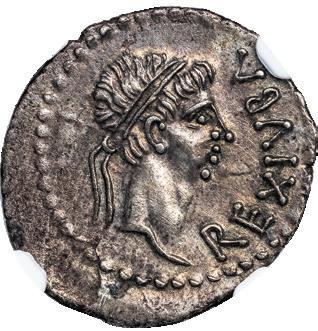


19417. KINGDOM OF MAURETANIA. JUBA II with CLEOPATRA SELENE, 25 BC–AD 23/4. Silver Denarius, 2.97 g, 18 mm. Issue of Caesarea, Mauretania, ca. AD 11–23/24. Obv. REX IVBA, diademed head of Juba II right. Rev. KΛЄΟΠΑΤΡA BACIΛICCA, crocodile left, head raised. Mazard 344.
NGC graded AU, Strike 5/5, Surface 3/5, “brushed,” with dark gray toning flashing with colorful highlights.
$ 3000
$ 3700
It is interesting to note that while Juba’s legend is in Latin (Rex Iuba = King Juba) that of Cleopatra is in Greek, a convention making reference to her royal Macedonian and Egyptian heritage. Furthermore, on this coin type, the crocodile, a consummate symbol of Egypt, is restored to prominence even though on the Roman coinage of Augustus it was employed to illustrate a defeated Egypt.
23
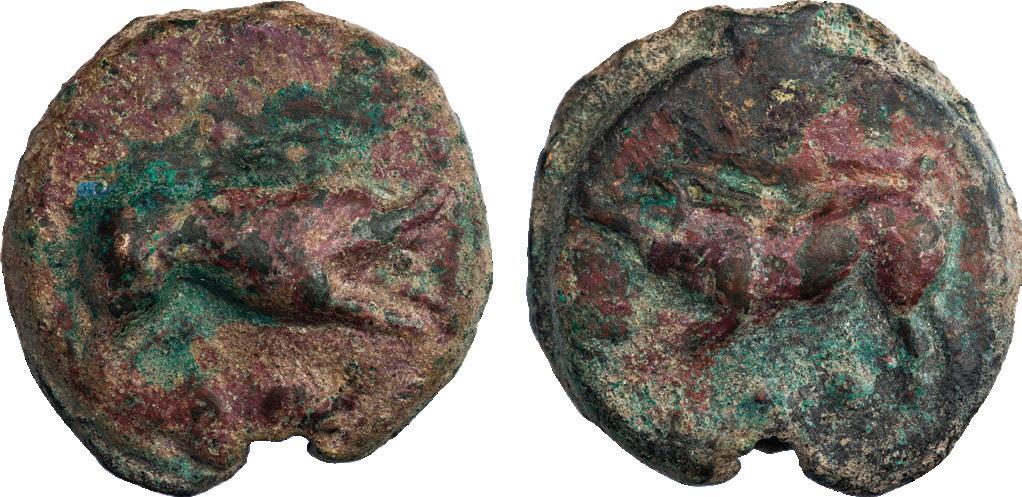
17568. ROMAN REPUBLIC. ANONYMOUS. Ca. 270 BC.
Bronze Aes Grave Quadrans, 82.60 g, 42 mm. Issue of Rome.
Obv. Boar charging right, three pellets below (mark of value). Rev. Boar charging left, three pellets below (mark of value).
Crawford 18/4; Sydenham 18; Rutter HN Italy 282.
Ex Judy Day Frink Collection, acquired from Frank Kovacs.
PUBLISHED: Vilmar Numismatics FPL III, no. 122.
VF, dark green and red patina, casting hole on the bottom. $ 1450

17574. ROMAN REPUBLIC. ANONYMOUS. Ca. 225–217 BC.
Bronze Aes Grave Triens, 105.10 g, 46 mm. Issue of Rome.
Obv. Helmeted head of Minerva left, four pellets (mark of value) below, all on raised disk. Rev. Prow right, four pellets below, all on raised disk.
Crawford 35/3a; Sydenham 74; Rutter HN Italy 339.
Ex Judy Day Frink Collection.
PUBLISHED: Vilmar Numismatics FPL III, no. 121.
Good VF, dark green patina, some areas of smoothing on edge. $ 2500


19462. ROMAN REPUBLIC. ANONYMOUS ISSUE, ca. 211–208 BC.
Silver Victoriatus, 3.13 g, 17 mm. Issue of an uncertain mint.

Obv. Laureate head of Jupiter right. Rev. ROMA, Victory standing right, crowning trophy, VB ligate monogram in center field.
Crawford 95/11; Sydenham 113.
NGC graded MINT STATE, Strike 5/5, Surface 5/5. $ 1250
The silver victoriatus denomination was introduced in c. 221 BC, apparently as a half of the defunct quadrigatus stater of the Roman Republic. It gained its name from the depiction of Victory crowning a trophy of arms on the reverse. Interestingly, in Greek, the denomination was known as the tropaikon, after the trophy, rather than the figure of Victory. The denomination seems to have been struck primarily as a replacement for the drachm in Cisalpine Gaul and southern Italy while Rome adopted a new standard based on the silver denarius. The lower purity of the metal and weight of the victoriatus led to it being officially valued as 1/3 of a denarius.
24


19109. ROMAN IMPERATORIAL. M. JUNIUS BRUTUS, d. 42 BC.

Silver Denarius, 3.81 g, 18 mm. Issue of Rome struck by Brutus while he served as moneyer, 54 BC.
Obv. BRVTVS, head of L. Junius Brutus right, within dotted circle. Rev. AHALA, head of C. Servilius Ahala right.
Crawford 433/2; Sydenham 907.
NGC graded CHOICE VF, Strike 5/5, Surface 3/5, “edge cut.”
$ 1650
A historical coin on so many levels, this is part of an emission struck by the infamous Brutus, Caesar’s assassin, a decade earlier when he served as moneyer. The portraits on the coin make reference to his family’s proud history of service to the Republic as they illustrate L. Junius Brutus and C. Servilius Ahala. L. Junius Brutus was the man who banished the Tarquin kings and established the Republic while Ahala, a descendant on his mother’s side, was responsible for killing another politician who aspired to kingship. The coin, with its overwhelming pro–Republican sentiment, anticipates M. Junius Brutus’ role in the murder of Caesar.


18287. ROMAN IMPERATORIAL. JULIUS CAESAR, d. 44 BC.
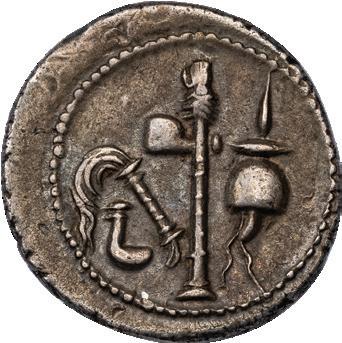
Silver Denarius, 3.93 g, 19 mm. Issue of a military mint traveling with Caesar, 49–48 BC. Obv. CAESAR, elephant to right, trampling a serpent. Rev. Official instruments of the Pontifex Maximus – simpulum, aspergillum, securis and apex.
Crawford 443/1; Sydenham 1006.
Ex Salton Collection, likely acquired in the 1950s–1960s when Mr. Salton owned a numismatic firm in New York.
NGC graded CHOICE XF, Strike 5/5, Surface 4/5, “edge marks,” dark cabinet toning, with exceptional centering and superbly detailed elephant. $ 3500


19359. ROMAN IMPERATORIAL. JULIUS CAESAR, died 44 BC.

Silver Denarius, 3.89 g, 21 mm. Posthumous issue of Ti. Sempronius Gracchus at Rome, ca. 40 BC. Obv. Laureate head of Caesar right within finely dotted border, S–C in field. Rev. TI SEMPRONIVS Q DESI GRACCVS, signum, aquila, aratrum, and decempeda.
Crawford 525/4a; Sydenham 1129.
Ex Numismatica Ars Classica 46, 4/2/2008, lot 947.
NGC graded CHOICE VF, Strike 5/5, Surface 4/5, FINE STYLE, with an elegantly classicizing portrait of Julius Caesar. $ 5950
25


17769. ROMAN EMPIRE. AUGUSTUS, 27 BC–14 AD.

Silver Denarius, 3.78 g, 19 mm. Issue of a Spanish mint, perhaps Emerita, ca. 19/18 BC. Obv. CAESAR AVGVSTVS, head of Augustus right. Rev. SIGNIS RECEPTIS, Mars, standing left and looking right, holding aquila and standard.
RIC I rev, 82a; BMC 414.
NGC graded CHOICE XF, Strike 4/5, Surface 2/5, with superb multicolored iridescence. The reverse type refers to Augustus’ political victory through which he obtained the return of Crassus’ lost standards from the Parthians. $ 2800
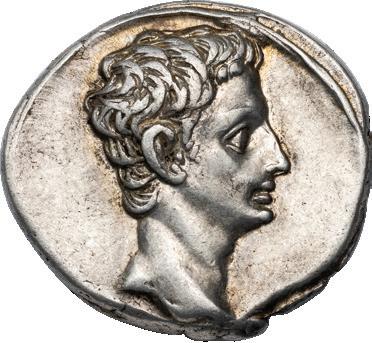
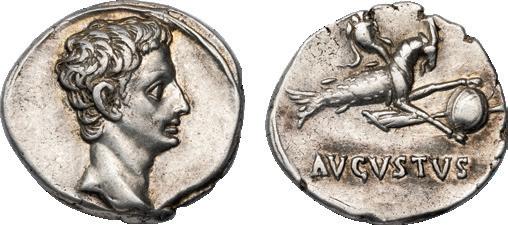
19112. ROMAN EMPIRE. AUGUSTUS, 27 BC–14 AD.
Silver Denarius, 3.81 g, 19 mm. Issue of an uncertain Spanish mint, ca. 18–16 BC.

Obv. Head of Augustus right. Rev. AVGVSTVS, Capricorn right, holding globe with bands and rudder, cornucopia perched on its back. RIC I 126; RSC 21.
Ex NAC 92, 5/23/2016, lot 467.
NGC graded CHOICE XF, Strike 5/5, Surface 4/5, “lt. graffito.” $ 2950
The Capricorn is among the most interesting of all images on Augustus’ coinage since it was promoted as the emperor’s astrological sign guaranteeing his great rule and the prosperity that would accompany it. Even the Roman biographer, Suetonius, the man who wrote the Twelve Caesars, mentioned the Capricorn: “From this moment (when an astrologer acknowledged Augustus’ greatness after reading his horoscope) he had such great faith in his own destiny that he made public his horoscope and later minted a silver coin with the Zodiac sign Capricorn, under which he was born” (Suetonius, Augustus, 94, as cited in Zanker’s The Power of Images in the Age of Augustus, p. 48). This specimen is particularly interesting in that it shows a series of bands on the left side of the globe, recalling bands of Zodiac symbols often rendered on Roman globes such as one held by the personification of eternity, a winged male, in the 2nd century AD base to the Column of Antoninus Pius.
COIN STRUCK AT ANTIOCH IN THE BIRTHYEAR OF JESUS CHRIST



19398. ROMAN EMPIRE. AUGUSTUS, 27 BC–AD 14. PROVINCIAL ISSUE OF ANTIOCH. Silver Tetradrachm, 14.88 g, 28 mm. Issue of year 26 (Actian era) with consular date XII (5 BC). Obv. KAIΣAΡΟΣ ΣΕΒΑΣΤΟΥ, laureate head of Augustus right. Rev. Tyche seated right on rocky outcropping, holding palm, river god Orontes swimming to right, ETOYΣ SK (Actian Era date = 26) above; in right field, IB (consular date = XII) above civic monogram (ANTIOXIEΩN?).
Prieur 50; RPC 4151; McAlee 180.
NGC graded AU, Strike 5/5, Surface 2/5.
$ 2500
26
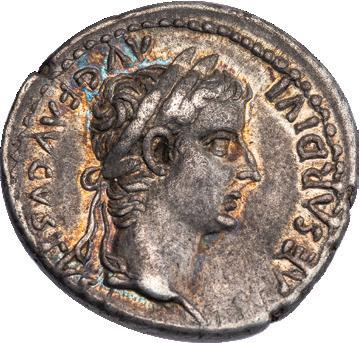
17318. ROMAN EMPIRE. TIBERIUS, AD 14–37.
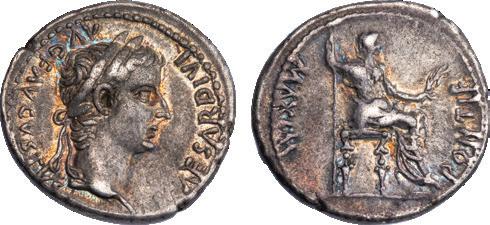
Silver Denarius, 3.85 g, 19 mm. Issue of Lugdunum (Lyon).

Obv. TI CAESAR DIVI AVG F AVGVSTVS, laureate head of Tiberius right. Rev. PONTIF MAXIM, female figure (Livia as Pax) seated right on throne, holding scepter and olive branch.
RIC I rev 30; Hendin 6th edition 6656.
PUBLISHED: Vilmar Numismatics FPL III, no. 141.
NGC graded CHOICE VF, Strike 4/5, Surface 4/5, with golden iridescence and a classicizing Julio–Claudian style portrait. $ 1500



19316. ROMAN EMPIRE. VESPASIAN, AD 69–79.
Silver Denarius, 3.09 g, 17 mm. Issue of Rome, AD 72–73.
Obv. IMP CAES VESP AVG P M COS IIII, laureate head of Vespasian right. Rev. VICTORIA AVGVSTI, Victory standing right, holding palm, and crowning a military standard (signum).
RIC II.1 362.
NGC graded XF, Strike 4/5, Surface 4/5.


19016. ROMAN EMPIRE. DOMITIAN, AD 81–96.
Silver Denarius, 3.49 g, 19 mm. Issue of Rome, AD 92–93.

$ 750
Obv. IMP CAES DOMIT AVG GERM P M TR P XII, laureate head of Domitian right. Rev. IMP XXII COS XVI CENS P P P, Minerva advancing right, holding raised spear and shield, on capital of rostral column, owl at her feet.
RIC II.1 740.
Ex Numismatik Naumann 48, 11/20/2016, lot 561.
NGC graded CHOICE XF, Strike 5/5, Surface 4/5, exceptional struck, with violet highlights on a beautiful dark gray cabinet toning. $ 1200
27
THE FAMED “TRIBUTE PENNY” OF THE BIBLE



14616. ROMAN EMPIRE. HADRIAN, AD 117–138. Silver Cistophorus, 10.59 g, 30 mm. Issue of Ephesus. Obv. HADRIANVS AVG COS III PP, head of Hadrian right. Rev. DIANA EPHESIA, cult statue of Diana Ephesia facing, flanked by stags.
Metcalf, Cistophori, type 5; RIC III 1328 (RICOnline lists 31 specimens – for which see the link: https://rpc.ashmus.ox.ac.uk/ coins/3/1328).
NGC graded VF, Strike 4/5, Surface 3/5, “overstruck,” with a great image of the famous cult statue at Ephesus. $ 850


19435. ROMAN EMPIRE. MARCUS AURELIUS, AD 161–180. Bronze Sestertius, 24.71 g, 29 mm. Posthumous issue of Rome, AD 173.

Obv. DIVVS M ANTONINVS PIVS, head of Marcus Aurelius right. Rev. S-C, Mercury standing left on pedestal holding purse and caduceus, within a tetrastyle temple, RELIG AVG in exergue. RIC III 1075; Banti 256. Ex W. Toliver Besson collection.
VF, slight porosity, scratches, edge smoothing [may be encapsulated upon request].
The peculiar tetrastyle temple containing the image of Mercury on this sestertius is believed to celebrate the so–called “miracle of the rain” that took place during the First Marcomannic War (168–174). During the campaign of 172, Cassius Dio reports that the legionaries of Legio XII Fulminata were pinned down by the warriors of the Germanic Quadi and suffering badly from thirst. The Romans were moments away from surrender when a sudden cloud burst allowed them to replenish their water supply and regain their strength to push back the enemy. This miraculous salvation, which is depicted on the Column of Marcus Aurelius, was credited at the time to Arnuphis, an Egyptian magician attached to the army and his prayers to the god Thoth, who was equated with Greek Hermes and Roman Mercury.
$ 500
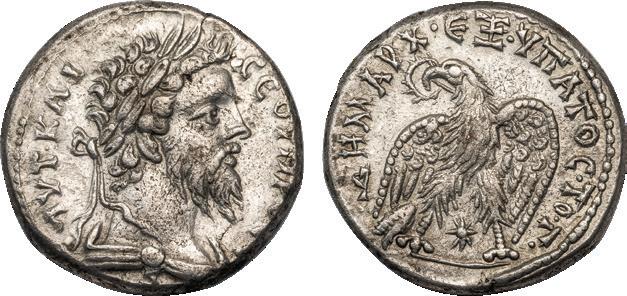
19380. ROMAN EMPIRE. SEPTIMIUS SEVERUS, AD 193–211. PROVINCIAL ISSUE OF LAODICEA AD MARE, SYRIA. Billon Tetradrachm, 13.03 g, 25 mm. Issue of year 3, ca. AD 208–209.
Obv. AVT KAI CЄOYHPOC CЄ, laureate and draped bust of Septimius Severus right. Rev. ΔHMAPX ЄΞ VΠATOC Γ, eagle right, head turned left holding wreath, star between legs. Prieur 1149.
NGC graded XF, Strike 4/5, Surface 3/5, with a great imperial portrait.
$ 975
28

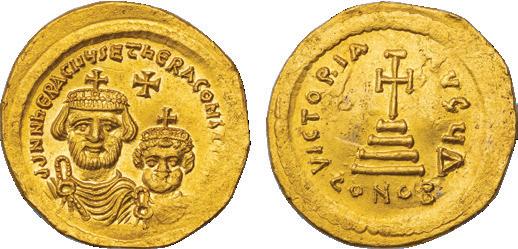

19485. BYZANTINE EMPIRE. HERACLIUS WITH HERACLIUS CONSTANTINE, AD 610–641.
Gold Solidus, 4.39 g, 21 mm. Issue of Constantinople officina Δ.
Obv. dd NN hЄRACLIЧS ЄT hЄRA CONST [PP AV Ч], facing busts of Heraclius (left) and Heraclius Constantine (right), cross above. Rev. VICTORIA AVϚЧ Δ, cross potent on stepped base, CONOB in exergue. Sear 734; DOC 8d.
NGC graded MINT STATE, Strike 4/5 Surface 3/5, “slight bend,” “clipped.”



19396. BYZANTINE EMPIRE. HERACLIUS WITH HERACLIUS CONSTANTINE, AD 610–641.
Silver Hexagram, 6.37 g, 23 mm. Issue of Constantinople, ca. AD 613–641.
$ 1100
Obv. dd NN ҺЄRACLIЧS ЄT ҺЄRA CONIC P P, Heraclius (left) and Heraclius Constantine (right), facing, seated on a double throne, both holding a globus cruciger, cross above. Rev. dЄЧS AdIЧTA ROMANIS, cross potent on globe on three steps, K in right field. Sear 798; DOC 64.
NGC graded VF, Strike 4/5 Surface 3/5, “brushed.”


17951. BYZANTINE EMPIRE. BASIL I WITH CONSTANTINE, AD 868–886.
Gold Solidus, 4.42 g, 20 mm. Issue of Constantinople.

$ 350
Obv. +IhS XIS RЄX RЄGNANTIЧM, Christ Pantocrator enthroned, facing, holding Gospels and raising his right hand in benediction. Rev. BASILIOS ЄT COhStAhtI AЧΣΣ I, facing busts of Basil and Constantine holding patriarchal cross between them. Sear 1704.
NGC graded MINT STATE, Strike 5/5, Surface 3/5, “edge marks.”
$ 1925
29
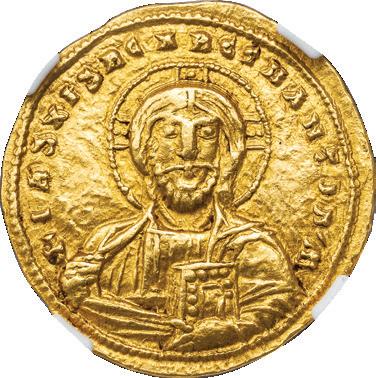

19504. BYZANTINE EMPIRE. NICEPHOROS II, AD 963–969.
Gold Histamenon Nomisma, 4.38 g, 22 mm. Issue of Constantinople.

Obv. Facing bust of Christ holding Gospels and raising his right hand in benediction. Rev. Facing busts of the Virgin and the emperor holding patriarchal cross.
Sear 1778.
Ex Jonathan K. Kern Collection.
NGC graded CHOICE AU, Strike 5/5, Surface 5/5, Kern provenance noted on holder.


19548. BYZANTINE EMPIRE. CONSTANTINE IX, 1042–1055 AD.
Gold Histamenon Nomisma (skyphate), 4.42 g, 29 mm. Issue of Constantinople.
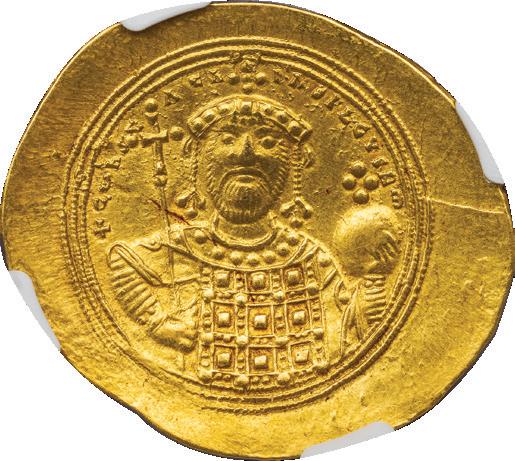
$ 3750
Obv. + IҺS XIS RЄX RЄGNANTIҺM, facing bust of Christ, holding Gospels and raising his hand in benediction. Rev. + CωҺSTATҺ
ЬASILЄЧS Rm, bearded bust of the emperor, holding long cross and globus cruciger with pelleted cross. Sear 1830.
NGC graded CHOICE XF, Strike 5/5, Surface 4/5. $ 1450


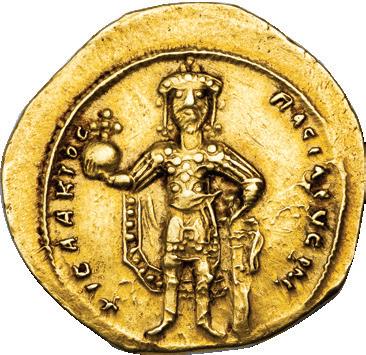
19124. BYZANTINE EMPIRE. ISAAC I, AD 1057–1059
Gold Tetarteron Nomisma, 4.04 g, 20 mm. Issue of Constantinople.
Obv. + IҺS XIS RЄX RЄϚNANTIҺm, facing bust of Christ holding Gospels. Rev. + ICAAKIOC BACIΛЄVC PM, Isaac I, standing, facing, holding globus cruciger and sword. Sear 1845.
NGC graded XF, Strike 5/5, Surface 3/5, “brushed,” a scarce emission of Isaac’s reign. $ 2475
30













































































































































































































